Genre: Platformer Developer: Sega of Japan Publisher: Sega of Japan Players: 1 Released: 1988
A lesser known game based on a long-running Japanese manga and anime series, Osomatsu-kun: Hachamecha Gekijo is a platforming action adventure and one of the earliest games to be released on the Sega Mega Drive. Like many obscure Japanese games, there was no attempt made at localization. And though the text is kept to a minimum diffusing the potential problem of a language barrier, after playing through Osomatsu multiple times it is apparent why this game never made the jump to western shores.
A typical combat-heavy platformer, Osomatsu bears minor resemblance to various other games in the genre, while containing its own unique qualities. The objective of each stage is to find and defeat the mini boss which will allow you to access the end level boss. This may seem simple at first until you realize that the levels in Osomatsu are non-linear and contain multiple paths, though this is implemented rather poorly and often acts as a hindrance more than a reason to replay the game. While you walk to the right of the screen and cannot move backward, there are multiple areas you can visit by way of doors, floating clouds and even pitfalls. Go the wrong way and you will go back where you started. They key to success is finding out the correct path you need to take to advance to the next stage, which is perhaps a good thing since there are only three main stages in the entire game. And although you will die multiple times while learning the level layout, Osomatsu is short; once you memorize the proper path, the game can be beaten in under ten minutes.
Peppered throughout the three short levels are minor diversions such as shops you can visit to purchase power-ups, and two mini-games which can yield more health, points and extra lives. Throughout the game you will spend a good chunk of time collecting ribbons scattered around the level, as well as one-up cards (six can be traded in for an extra life) which are also received by killing enemies. These work as currency which can be used to fill up your inventory with useful items such as wings that allow you to fly freely around a level, or fireworks that can be dropped and used to inflict major damage on boss enemies. Your main weapon is a slingshot with infinite ammo which can be used to fight enemies and destroy projectiles and as you defeat each end level boss your range with this weapon will increase along with your health. Osomatsu controls well in general and with the ability to duck and perform a high jump you will quickly learn how to avoid many of the smaller enemies in the game, saving yourself a lot of grief in the process.
Osomatsu can be a frustrating affair at times due to seemingly random, erratic enemy placement. Although there are no pitfall deaths, every jump you make is one where you risk taking damage, usually from a projectile or enemy spawning beneath you on the next platform, not giving you any real chance to progress unless you know exactly what will happen next. So while you can argue that the short length of the game is offset by the fact that you need to know everything perfectly in order to be successful, it really feels like a cheap ploy to increase the difficulty without actually making the game more challenging. Enemies are difficult to hit due to the initially low range of your slingshot, and due to somewhat sluggish movement, their projectiles can be difficult to safely avoid. However, once you reach the third and final level your weapon is powered up significantly allowing you to easily plow through enemies. This creates something of a strange difficulty curve, as the earlier parts of the game are much difficult than the ending.
As far as the visuals go, the game looks fairly good. Backgrounds are vibrant and colorful, characters are simple but stylistic, and each level has multiple sections made up of changing environments which help keep the game fresh throughout. You will traverse underground caves, cloudy platforms in the sky, a hilly area with a very Japanese sun rise, grassy plains with mushroom trees, and a prehistoric landscape right out of the Flintstones. Character animations are limited and rather unimpressive, but they have a simplistic charm from another era and are very easy on the eyes. Osomatsu has several amusing facial expressions which change from happy to sad as his health bar goes down, but enemies are fairly static for the most part. The sound is nothing to write home about, the music is sometimes catchy but usually repetitive, and the effects are functional but otherwise nothing that you will remember after turning off your console. The game certainly carries a style along with it that reflects the general cartoony goofiness of the source material but all in all, though the wrapping paper here is fairly nice it unfortunately can’t save the crummy gray sweater hidden underneath.
Although I had fun playing Osomatsu, it was a fairly forgettable experience. I feel as though it could have been much more enjoyable if they had lightened up on the “forest of illusions” gameplay gimmick and went with more unique stages instead. If you find it for a few bucks it might be worth a look, but with so many other great action platformers available for the system, it will probably not be an integral addition to your collection. While it has my respect for maintaining its own unique style, and for attempting to do something unique in terms of gameplay, the overall experience is ultimately rather shallow. Just as soon as I got to know the game it was over and it left me feeling cold, and wishing there had been more for me to sink my teeth into. Some games are simply not worth localizing and in retrospect, Osomatsu was probably one of them.
SCORE: 5 out of 10


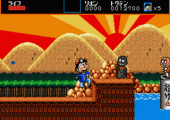
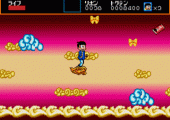
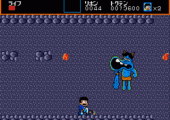
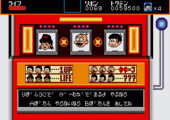
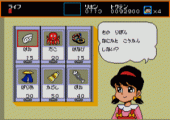
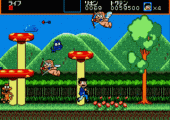
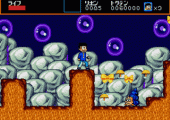
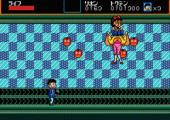
Recent Comments